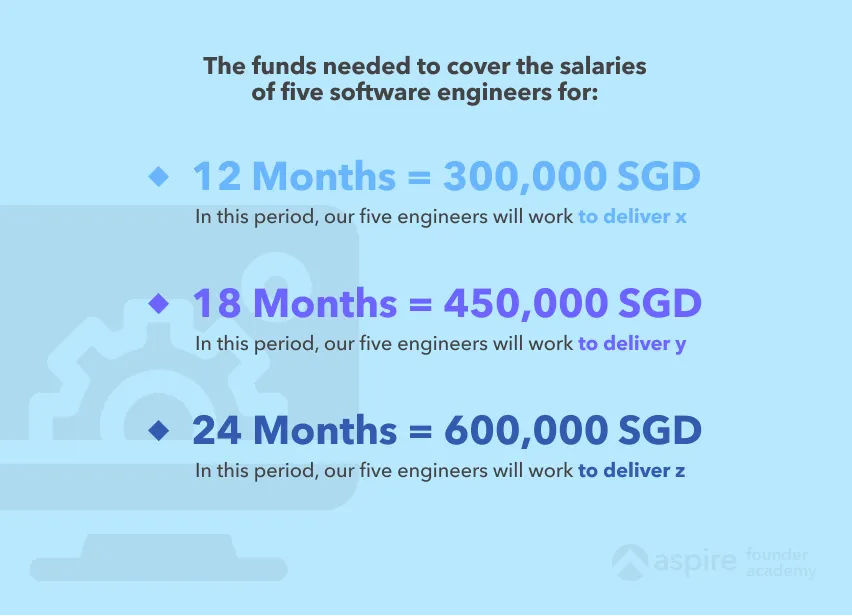Summary
You’ve reached the perfect time to start raising funds and you’ve even identified a few potential investors.
One of the key questions you’ll face now is how much money you need. But how much do you need? And is it an acceptable amount to ask for?
There are two ways to approach this. Let’s dig in.
Approach 1: Tie funding to new milestones
Milestones are an effective way to track business growth. A good milestone is realistic and typically attainable within two years.
Anything beyond two or three years tends to be hopeful, and investors rarely place their bets based on hope.
How to begin
Evaluate your current business performance and determine what new milestones you want to achieve in the next two to three years.
Cap it at three milestones and set a North Star metric to keep your efforts focused.
How to decide your financial needs
For each of your milestones, work out how much time and money you’ll need.
To start, consider the costs involved in achieving each specific milestone.
For example, you have a milestone of hiring three software engineers to validate your current app structure and build key new features. Factor in the time you’ll spend sourcing, interviewing talents and negotiating contracts.
If you’re planning to outsource the process to a talent agency, find out how much they charge. Don’t forget to include the legal costs involved in drafting contracts. The cost you arrive at will form part of the total sum of funds you’ll need to raise.
Example milestones
Examples of milestones include: Hiring new people, launching a key feature and improving your revenue model.
Each milestone achieved is another step up for your business. And each step increases the value of your business and makes it more attractive in future fundraising rounds.
How to pitch your needs
Seeking a single lump sum could result in an immediate “too much” or “too little” impression from investors and prompt a conversation that revolves around figures rather than what they can achieve. This situation can be challenging to reverse.
Instead, consider leading your presentation with the milestones you’ve identified. Pair each milestone with the funds required to achieve them. Like this, you can easily show potential investors how much value each tier of funding will bring your business.
Such an approach will steer the conversation to a milestone-based funding angle, which is much more objective. You will leave the room with a good idea of how investors perceive your milestones and how many of them they’re interested in funding.
Approach 2: Tie funding to business operations
An alternative approach to determining your fundraising figure is to work out your future costs. Add up how much it costs to pay your team’s salary for a given time and the projected new and improved features that will result from this effort.
An early-stage tech start-up usually consists of the founders and around three to five software engineers. According to Glassdoor, the average salary of a software engineer in Singapore is 5,000 SGD per month.
If you’re planning to hire five engineers for twenty-four months, you’ll need an investment of 5,000 SGD x 5 x 24 months, which equates to 600,000 SGD.
In this approach, provide a sliding option in the number of months (M) that investors can fund. For example, if M is 12 months, you’ll need 300,000 SGD. If M is 18 months, you’ll need 450,000 SGD.
Your presentation will contain a slide that looks something like this:

It’s essential to clearly define x, y and z as it links the amount to a specific objective, helping investors understand what your engineers will be developing within a given time frame.
If you need some help calculating how much you need to raise, try the Startup Growth Calculator by Y Combinator’s Trevor Blackwell. Note that it assumes steady expenses and consistent revenue growth.
Average raised per round

What to expect during a pitch meeting
Choosing one approach, crunching the numbers and delivering your pitch in a way that captures the heart of your growing business is half the battle. The other half is receiving and working on feedback from investors.
Never forget that investors have their own agenda, and their bottom line is to make money. All angel investors and VCs have different risk appetites, budgets and criteria for investment.
Be attentive to signs or cues of hesitation from investors and ask for feedback. They might require more context or find that your plan doesn’t fit their criteria. Either way, asking questions will help you understand their worries and clarify your message.
Keep in mind: when you meet an investor, the goal isn't to close the deal on the same day. You're asking for a substantial amount of funds and a leap faith from investors, so the important part of the first meeting is to get a second meeting.
As you’ll probably be meeting with multiple investors, raising money can take anywhere between three months to a year. And the next funding round might take just as long, so take this into account when you determine the funds you’ll need.

How to raise more money, faster
The fundraising cycle moves notoriously slow. It can take anywhere between three months and a year, especially when the answer is “no”.
One possible reason for this is that investor networks are small and information on pitching companies gets passed around frequently.
Hence, investors have prior knowledge of whether a company they’re about to meet is sought-after or rejected by other investors. Knowing such information gives investors leverage, which they often use to set the pace and terms of a company’s fundraising campaign.
But there is a way to speed up the process. Y Combinator Group Partner Aaron Harris highlights the power of leverage in the pursuit of fundraising.

So how do you convince investors that your start-up is one of these outliers?
Find a way to combine traction, team, vision, market opportunity and product to demonstrate your company’s attractiveness and potential success.
And use these tips to make the fundraising process more time-efficient.
Tip 1: Research potential investors and make a shortlist of those whose interests, portfolio, experience and connections align with your company’s.

Tip 2: Schedule pitch meetings with different investors as tightly as possible.

Pitching to the right investors and minimising the potential for them to exchange information before making a decision are key factors to raising more money, faster.
Fundraising means more than just raising money
Raising money for your start-up is rarely a one-time event. Before your business reaches profitability, you’ll almost always need to draw in more investors to help take it to the next level.
So remember it’s not only about the money. You’re choosing long-term partners for your business. Therefore, you better look for investors who can guide and mentor your team. Even if this comes at the cost of lower funding.










%201.webp)


.webp)